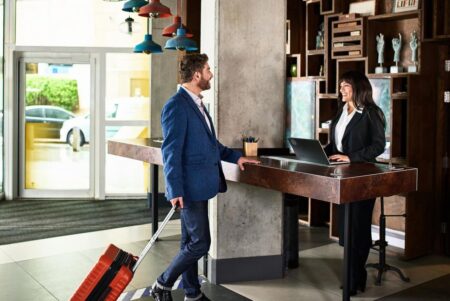The QSR pizza segment is fiercer than ever, yet few brands like Papa John’s have weathered the decades. Founded on a promise of quality and propelled by an early leap into digital ordering, the company now boasts more than 6,000 restaurants worldwide.
To understand how the brand continues to evolve, I questioned CEO Todd Penegor and Chief Development Officer Joe Sieve for an unfiltered discussion about technology, franchise growth, and staying true to a 40‑year‑old slogan in a world that moves at app speed. Our unaltered and complete conversation is framed by the insights that emerged between the lines.
Gary Occhiogrosso: Papa John’s is one of the most recognizable pizza brands in the world. Which key moments or milestones helped solidify the company’s place as a household name?
Todd Penegor: Our intentional focus on quality and craftsmanship has drawn people to Papa John’s. Over the years, Papa John’s worked to make that premium pizza experience accessible and convenient in ways that had not been done before in our industry. We were the first national pizza company to offer online ordering at all of its U.S. delivery restaurants in 2001, the first to process online payments using a credit/debit card in 2005, and the first to launch a nationwide digital rewards program in 2010.
Occhiogrosso: What role did the company’s early focus on “Better Ingredients. Better Pizza.” play in establishing brand identity, and how are you refreshing that messaging to resonate with new and loyal customers?
Penegor: “Better Ingredients. Better Pizza.” has always been more than a slogan; it’s the foundation of our brand, and it communicates a core promise that’s built trust and loyalty among millions of customers worldwide. That promise will continue to guide everything we do to enhance the customer experience, from menu innovation to loyalty programming.
By infusing that promise across all customer touchpoints and strengthening our commitment to quality, we can create new fans of Papa John’s and deepen our relationships with our most loyal customers.
Papa Johns was one of the first QSR brands to build an online presence and provide new channels for customers to use when ordering pizza. Every brand has an app, and the digital experience is often the primary customer experience.
Occhiogrosso: What is Papa John’s vision for a differentiated digital experience, and what improvements do you think need to be made to make that experience a reality?
Penegor: We’ve got to make our customers’ digital experience seamless and convenient from the moment they first turn to Papa John’s to browse our menu to post‑delivery. To do that, we’re working to improve our app and website and evolve our Papa Rewards program.
We launched our first loyalty enhancement in mid‑November 2024, allowing customers to unlock Papa Dough faster. This drove lapsed consumers back to the brand and showed consumers a distinctive value proposition we could offer. Now that we have made Papa Rewards more valuable, we’re working to make the loyalty program more engaging and seamless, adding gamification. All along the way, we will be testing how we can continue to improve upon each touchpoint.
Occhiogrosso: What new operational technologies or service models are you exploring to improve ordering, delivery speed, and overall customer experience?
Joe Sieve: We’re making strategic moves to streamline operations and drive us toward two goals: efficiency and consistency. We must ensure that the tools and processes we know improve customer satisfaction (e.g., driver tracking technology, operations simplification, coaching, feedback) and are implemented across the entire system.
One key example is oven calibration. We’ve determined some differences among restaurants in oven temperature and bake time. Even small differences can have a big impact on the pizza that is ultimately delivered, factors like the initial presentation when a customer opens the box, the texture of the “cheese‑pull,” and the overall taste. So, we will be more rigorous in ensuring standards for these key settings that make a difference in the customer experience.
Occhiogrosso: With third‑party delivery services growing in popularity for the pizza category, how does Papa John’s prioritize partnerships with these platforms alongside in‑house delivery?
Penegor: We were one of the first national pizza brands to embrace third‑party delivery in 2019, and we’ve continued to strengthen those partnerships to enhance both operational efficiency and the customer experience. Pizza has always been at the forefront of food delivery, and we’ve worked to reach customers wherever they may be looking for pizza across the various channels of choice among our customers, including third-party aggregators. At the same time, we want to make ordering directly from Papa John’s the preferred channel for customers. When customers think of ordering pizza, we want them to choose our channels first. To do that, we have to provide them with a best‑in‑class experience that matches the premium nature of our products.
Occhiogrosso: As you continue to expand globally, how are you working with franchisees to ensure alignment with growth initiatives while maintaining strong profitability, and what kind of incentives or support systems are being introduced to attract new franchisees?
Sieve: At the end of last year, we celebrated the opening of the 6,000th Papa John’s restaurant, a milestone few brands achieve. As we expand globally, we’re working closely with franchisees to ensure alignment with our growth strategy by keeping their profitability front and center. That means ongoing investment in the restaurant economic model, streamlined decision‑making, and deeper collaboration with our restaurant support centers to foster open dialogue and feedback.
We’re also focused on attracting new franchisees who share our growth mindset. We are offering stronger support systems, operational testing for new initiatives before rollout, and a commitment to building a sustainable, scalable business model that works for both new and existing partners. We plan to roll out some new development initiatives closely tailored to our growth goals, whether shoring up existing markets or entering new ones.
Occhiogrosso: What key factors do you consider when selecting new growth markets, and how do you tailor your approach in different regions?
Sieve: It’s not just about where we grow but also how we grow. Every region has its own dynamics, so we adjust our strategy based on local consumer preferences, operational considerations, and supply chain readiness. Our commitment to profitable, sustainable growth is consistent across the board. We’re working closely with our franchisee partners to ensure we’re entering markets where we can deliver on our brand promise while giving customers a great experience.
For example, in some markets in North America, our restaurants are generating very high volumes of orders, which can affect factors such as delivery time. So, in places like that, we have an opportunity to maintain our standards of service, perhaps by opening more restaurants in the area to create optimized delivery areas.
Occhiogrosso: What are your franchisees’ pain points, and how are you working to address those?
Sieve: We know franchisee success is foundational to the strength of our brand, and our franchisee partners are clear about what they need to succeed. Some pain points we’ve heard are consistent with what we’re seeing across the industry: margin pressure, labor challenges, and sales declines, and that’s why we’re focused on enhancing value perception and upgrading our technology infrastructure to improve profitability and operational efficiency. We’ve recently rolled out a suite of new tools to empower our franchisees to drill down into the economics of each one of their restaurants, to show them the various factors driving the success of that restaurant versus other “like” restaurants, so we can help them identify opportunities for growing profitability.
Another key effort we have focused on is lowering the cost of building new restaurants. In the second half of 2024, among our corporate-owned restaurants, we achieved an average build cost of $515,000 per restaurant, about a 25% reduction from the year prior. We have been sharing what we learned from those efforts with our franchisees and are continuing to find new ways to lower build costs for them.
Occhiogrosso: In the very crowded pizza space, what unique points of differentiation might be compelling to a potential franchisee?
Sieve: We’ve built a brand based on a level of quality that our customers trust, and that translates into long-term loyalty and sustainable business for our franchisees. What is also compelling to franchisee partners is that we’re not chasing growth for growth’s sake. Rather, we’re building a system where every restaurant has the tools, support, and infrastructure to succeed. When a franchisee is ready to grow, we work alongside them to plan the right volume and speed of growth for the markets they serve. And, unlike others in the pizza industry, our franchisees have many opportunities to explore – whether infill in an existing market or lead the charge into an area not yet served by Papa John’s.
Occhiogrosso: Franchisee relations are critical to any brand’s success. Can you share how Papa John’s ensures franchisees remain profitable amid rising labor and supply chain costs and what actions you are taking to prevent franchisee turnover?
Sieve: The average tenure of a Papa John’s franchisee is about 15 years, and many of our partners operate multiple restaurants with plans to grow even further. While the industry continues to navigate material costs, we are in the process of kicking off a multi-year initiative to reduce costs across our supply chain. Our vertically integrated supply chain and regional quality control center network enable us to maintain quality, manage costs, and identify efficiencies.
When a particular restaurant or group of restaurants is underperforming, we work with franchisees to identify potential solutions to improve operations and continue serving the customers in that area who have come to rely on Papa John’s. In several cases, restaurant transfers from one franchisee to another have driven dramatic turnarounds in the sales performance of those restaurants, as the incoming franchisee improved service levels, found new ways to deliver value to customers, and boosted morale among team members.
One key effort we have been focused on is lowering the cost of building new restaurants. In the second half of 2024, among our corporate-owned restaurants, we achieved an average build cost of $515,000 per restaurant, about a 25% reduction from the year prior. We have been sharing what we learned from those efforts with our franchisees and are continuing to find new ways to lower build costs for them.
Occhiogrosso: Sustainability and social responsibility are becoming key factors in consumer decision-making. How is Papa John’s incorporating sustainability into its operations, and what concrete steps are being taken to reduce the environmental footprint of both the corporate and franchise operations?
Penegor: Sustainability is an ongoing priority for our customers, franchisees, and businesses. At Papa John’s, we’re focused on reducing our environmental footprint through energy efficiency and food waste reduction efforts.
First, regarding energy efficiency, we’re looking to reduce energy consumption across our operations, including our corporate-owned restaurants, quality control centers, and transportation fleet.
In corporate-owned restaurants, in 2024, our repairs and maintenance program included the installation of tankless water heaters and new refrigeration systems that produce fewer emissions. Our Energy Management System (EMS) enables us to monitor, control, and optimize electricity generation and transmission across our restaurants. We also continue to test Powerhouse Dynamics EMS technology, which allows us to monitor energy use in certain restaurants and gather critical data to understand the most significant users of energy. We also conducted tests to assess how adjustments in restaurant operating hours could potentially drive energy savings. This data will help identify opportunities to conserve power and inform decisions on prioritizing equipment upgrades to improve the energy efficiency of our restaurants.
We also aim to optimize our quality control centers, transportation, and logistics operations, which improves energy efficiency and reduces fuel consumption and associated emissions, including:
Using routing technology to ensure the most efficient delivery routes to our restaurants and reduce driving time on the road. In 2024, route optimization projects helped avoid more than 164,000 travel miles.
Expanding training within our Shore Power program provides an approximate 25% reduction in diesel fuel consumption each year by using electric power to refrigerate delivery trucks during loading, which can take up to five hours. As of 2024, all 12 of our QCCs are equipped with this technology.
Improving idling times across the fleet during loading and unloading through technological advancements and educational efforts among our drivers.
Secondly, to prevent food waste, we use forecasting tools and an inventory management system to source ingredients accurately and have a donation program for when orders are incorrect or go uncollected. Through our Harvest Program in the U.S., in partnership with Food Donation Connection, surplus meals are donated to over 280 community organizations. In 2024, through nearly full participation across our corporate restaurants and the Test Kitchen in our Atlanta Restaurant Support Center (RSC), we donated nearly 360,245 meals. Since 2010, the program has diverted more than 1.7 million pounds of food that would have otherwise gone to landfills to help feed those experiencing food insecurity.
My Closing Thoughts
Penegor and Sieve paint a picture of a brand that refuses to coast on name recognition. Papa Johns is banking on operational rigor and data‑driven experimentation to keep the “Better Ingredients” promise fresh for a new generation of pizza lovers and franchisees- from recalibrating ovens to rewriting the rules of loyalty programs.
Papa John’s is betting that relentless consistency, smarter tech, and franchisee‑centric economics will keep the brand’s slice of the pie hot and growing for years in a market crowded with pizza choices.
Read the full article here











